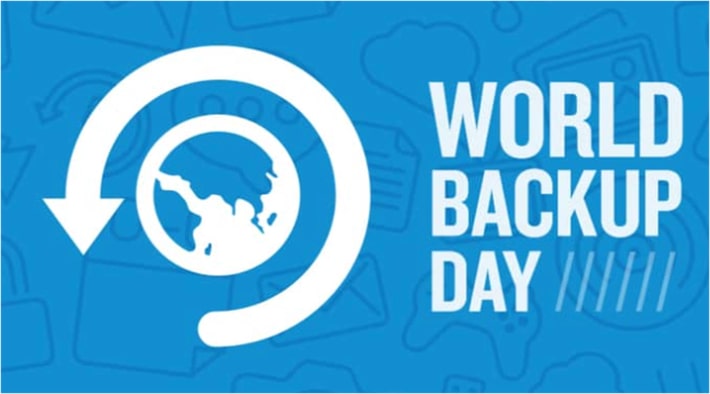Tragedy fell on WIRED Journalist Mat Honan, whose digital life was destroyed when hackers broke into his iPad account and wiped his computer, phone, and tablet, completely obliterating his data, all for what? A Twitter username! What happened to his backups? Did he have backups?

What would you do if you lost everything? If you think you’re safe, think again.
Today marks World Backup Day, celebrated annually by JIN TECH and all of the tech industry to promote awareness of the importance of protecting data and keeping systems and computers secure.

It was founded in 2011 by Ismail Jadun after a post made by a user on Reddit who wrote about losing their hard drive and wishing someone had reminded them about backing up their data. Therefore, this article is meant to serve as a reminder for you to back up your data and, of course, highlight relatively simple techniques to do so.
The problem with having no backups

Many times, we are complacent and approach issues of data loss as something that happens only to big tech companies. I mean, why would anyone want to hack me? But as you saw with Mat Honan, anyone can, for silly reasons like a Twitter username. One small incident could destroy all the important stuff you care about. If you lose your hardware, it could easily come by, but you know what’s hard to come by? That project you spent the entire month working on, the movies on your hard drive, and the digital memories of time spent with family and dear friends, all down the drain with no means to recover them.
So what do you do?
Back them up! And regularly too!

A backup refers to making copies of your files that you can’t bear to lose. Should something happen to the original, the copies would suffice, as you only need to restore the backups to your device from the backup service you used.
You can still take it a step further to backup those files — especially important ones — to at least three places, as advised by Ravi Pendekanti, senior vice president of HDD Product Management and Marketing at Western Digital, who highlighted a 3–2–1 backup rule where:
- 3 copies: maintain at least three copies of your important data.
- 2 different media: store two of those copies on different types of media, such as an external hard drive and a cloud storage service. This redundancy helps ensure you don’t lose everything due to a single point of failure (e.g., a broken hard drive).
- 1 offsite copy: Keep at least one copy of your data offsite. This could be in the cloud, at a friend’s house, or in a safe deposit box. This protects your data from physical disasters like fire or floods that could damage your local storage devices.
But wait; do you know the possible ways you can lose your data?
How do you lose your data?
- Accidental deletion: hitting the wrong button or accidental formatting
- Hardware Failure: Hard drive crash, SSD failure, device theft, or loss
- Software Issues: Malware or viruses, software bugs, OS failure
- Other causes: natural disasters, power surges, ransomware attacks
Now you know, what next? Take action!
Safety nets (Backups) to apply to your data
Interesting statistics show that 83% of us own a computer and 89% own a mobile phone, yet only one in four people makes regular backups of their data. Are you among the 1 in 4 persons or the 3 in 4 persons? Here are two data safety nets you can apply to prepare you for rainy days.
Local storage
- External hard drives are an affordable option for local backups. Ensure you choose a reputable brand and store the drive in a safe location separate from your compute
- Solid State Drives (SSDs): faster than traditional hard drives, generally more expensive, but a good choice for frequently accessed data.
Cloud storage
This is a convenient option for offsite backups, especially because the entire process can be scheduled as desired. There are many cloud storage services that offer free or paid plans with varying storage capacities. When choosing one, consider factors like security, reliability, and ease of access. This can further be divided into two:
For full backups:
You can use Backblaze or iDrive.
For storing a smaller amount of photos or files:
- OneDrive — 5 GB Free
- Apple iCloud — 5 GB Free
- pCloud — 10 GB Free
- Google Cloud — 15 GB Free
- MEGA — 20 GB Free
Other steps you can take today:
- Encrypt your backups to add an extra layer of security in case your backup media is stolen or lost.
- Test your backups regularly by restoring a few files from your backup to ensure everything is functioning correctly.
Rotate your offsite backups: If you store backups offsite physically (e.g., at a friend’s house), consider rotating them periodically to reduce the risk of losing everything in a single event.
Now that you know what to do, it’s time to take the World Backup Day pledge.

Say after me:
“I solemnly swear to backup my important documents and precious memories today, March 31st. I will also tell my friends and family about World Backup Day: Real friends don’t let friends go without a backup.”
Conclusion
Data backup should be something you are intentional about; otherwise, you stand the great risk of losing your life’s work and files all at once. By making the pledge, you have made the commitment to backup your data, so do so. Tomorrow is April Fool’s Day, and trust me, today being World Backup Day is the day that is trying to save you from the April Fool’s Day jokes that just go too far. I’m off to back up my data. I’ll see you soon. Remember to share to that friend that keeps procrastinating😂 and of course follow us on our blog for more insightful articles.

